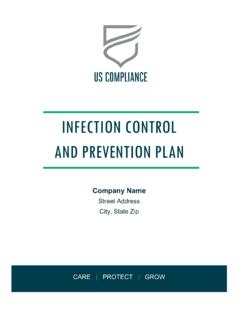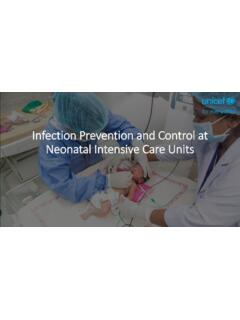Transcription of Advanced Infection Prevention and Control Training
1 Advanced Infection Prevention and Control Training May 2018 version 1 Prevention of catheter-associated urinary tract Infection (CAUTI): student handbook Introduction Welcome to the Prevention of catheter-associated urinary tract infections (CAUTI) module. This Advanced module is part of a broader Infection Prevention and Control (IPC) Training package targeting Advanced IPC focal points working in low-resource settings. It is designed to support the implementation of the WHO Guidelines on core components of Infection Prevention and Control programmes at the national and acute health care facility level1 as part of a multifaceted approach to capacity-building. Target audience This Training module is designed for individuals and teams who are intending to occupy a senior leadership position in IPC at the national, subnational or health facility level.
2 Trainees are expected to possess at least basic experience and competence in IPC. They could include IPC professionals, IPC hospital teams, facility administrators, hospital epidemiologists, microbiologists and other relevant health care professionals, among others. The package complements a basic Training package intended for all front-line health care workers. Learning objectives of the module The module aims to equip the Advanced IPC focal point to: explain the problem of CAUTI; explain catheter use, occurrence of CAUTI and related risk factors; recognize CAUTI and understand management principles; explain evidence-based (multimodal) implementation strategies for CAUTI Prevention including appropriate catheter insertion, maintenance and removal.
3 Purpose and content of the student handbook The module comprises a blend of PowerPoint presentations, videos and group work (including case studies and interactive question-and-answer sessions). The student handbook contains supplementary information to support learning, handouts that will be referred to during the Training , reflective reading for homework and group work instructions. Together with the PowerPoint slides it will form a valuable resource for students. The table below sets out the module s sessions and lists the associated resources contained within the handbook. 1 Guidelines on core components of Infection Prevention and Control programmes at the national and acute health care facility level.
4 Geneva: World Health Organization; 2016 ( , accessed 23 January 2018). Advanced Infection Prevention and Control Training May 2018 version 2 Session Resource Page 1. The problem of CAUTI Handout 1. Key points to note 3 Handout 2. My 5 Moments for Hand Hygiene Focus on caring for a patient with a urinary catheter 4 Handout 3. IFIC basic concepts of Infection Control , Chapter 18: Prevention of catheter-associated urinary tract infections 6 2. Catheter use, occurrence of CAUTI and related risk factors Handout 4. Quiz 1 14 Handout 5. Supplementary information related to quiz 1 15 Handout 6. Guide for Foley catheter use in hospitalized medical patients 16 Handout 7. Types of catheterization and catheters 18 Handout 8.
5 Common microorganisms causing CAUTI 19 3. Recognizing CAUTI and understanding management principles Handout 9. Collecting a catheter specimen of urine from the sampling port 20 4. Implementing evidence-based (multimodal, quality improvement-informed) strategies for CAUTI Prevention during catheter insertion, maintenance and removal Handout 10. Four key IPC principles and practices 21 Handout 11. Multimodal strategy trigger questions 23 Handout 12. Aseptic Non Touch Technique (ANTT) poster 25 Handout 13. Two case studies Kenya and United States of America 27 Handout 14. Additional reading list 28 Advanced Infection Prevention and Control Training May 2018 version 3 Handout 1. Key points to note Avoid urinary catheterization if possible!
6 When feasible, use a two-person team to perform insertion. Use sterile equipment and aseptic technique during insertion and aftercare/maintenance. Review the need for the catheter daily and remove as soon as possible when no longer needed (ideally within 48 hours). Hand hygiene is critical (especially moment 2 before an aseptic/clean procedure and moment 3 after blood and body fluid exposure). Don t change the catheter routinely if it is functioning properly. Maintain closed drainage. Bladder irrigation/washout and use of antiseptics/antimicrobial agents does not prevent CAUTI: do not use! Empty drainage bag regularly into a clean receptacle used only on one patient. The clean receptacle should be changed daily.
7 Advanced Infection Prevention and Control Training May 2018 version 4 Handout 2. My 5 Moments for Hand Hygiene Focus on caring for a patient with a urinary catheter The hand hygiene poster is available to download from: 5 Moments for Hand HygieneFocus on caring for a patientwith a Urinary Catheter3 RISKFLUID EXPOSUREAFTER BODY5 AFTERTOUCHING PATIENTSURROUNDINGSAll reasonable precautions have been taken by the World Health Organization to verify the information contained in this document. However, the published material is being distributed without warranty of any kind, either expressed or implied. The responsibility for the interpretation and use of the material lies with the reader. In no event shall the World Health Organization be liable for damages arising from its acknowledges for their active participation in developing this material the VA Ann Arbor Healthcare System & University of Michigan s Patient Safety Enhancement Program ( ),Ann Arbor, MI, United States, and Infection Control and Human Factors Laboratories, University Hospital Zurich, Zurich, Switzerland ( ).
8 1 BEFORETOUCHINGA PATIENT4 AFTERTOUCHINGA PATIENT2 BEFORE CLEAN/ASEPTICPROCEDURE Make sure that there is an appropriate indication for the indwelling urinary catheter. Use a closed urinary drainage system, and keep it closed. Insert the catheter aseptically using sterile gloves. Assess the patient at least daily to determine whether the catheter is still necessary. Patients with indwelling urinary catheters do not need antibiotics (including for asymptomatic bacteriuria), unless they have a documented KEY ADDITIONAL CONSIDERATIONS FOR A PATIENT WITH A URINARY CATHETERNo Action TodayNo Cure TomorrowCLEAN YOUR HANDS WHEN HANDLING A URINARYCATHETER AND DRAINAGE SYSTEMI mmediately before any manipulation of the urinary catheteror drainage system that could lead to contaminationof the sterile urine, such as:2a.
9 Inserting or applying an indwelling, intermittent straight, or condom catheter; immediately before putting on sterile gloves2b. Accessing the drainage system to collect a urine sample or to empty the drainage bagWHY? To protect the patient against harmful germs, including the patient's own, from entering his/her body. Immediately after any task involving the urinary catheteror drainage system that could lead to urine exposure, such as:3a. Collecting a urine sample 3b. Emptying the drainage bag3c. Removing the urinary catheterWHY? To protect yourself and the health-care environment from harmful patient YOUR HANDS WHEN HANDLING A URINARYCATHETER AND DRAINAGE SYSTEMA dvanced Infection Prevention and Control Training May 2018 version 6 Handout 3.
10 IFIC basic concepts of Infection Control , Chapter 18: Prevention of catheter-associated urinary tract infections The chapter is available to download from: 1 Chapter 18 Prevention of Catheter-Associated Urinary Tract infections Nizam Damani Key Points x Urinary catheterisation should be avoided if possible. If needed, then catheter should be reviewed on a daily basis and removed as soon as clinically possible, preferably within 5 days. x Urinary catheterisation should be performed using sterile equipment and aseptic technique should always be maintained during insertion and aftercare procedures. x Hands must be properly washed before and after procedure and during daily management. x Catheters should not be changed routinely as this exposes the patient to increased risk of bladder and urethral trauma.












